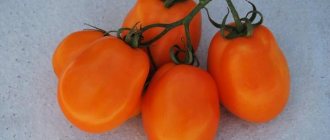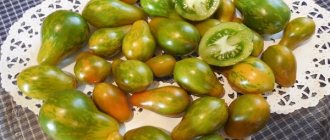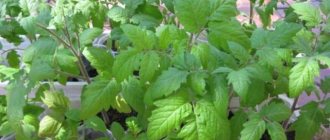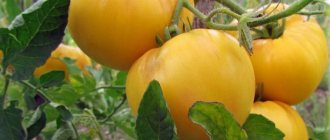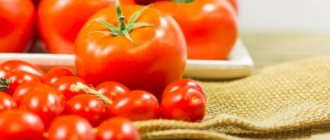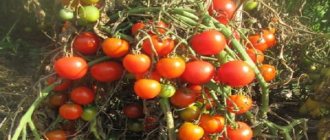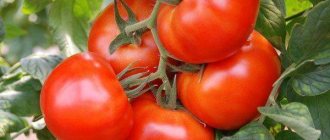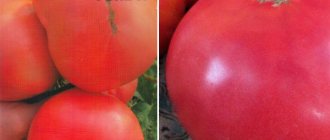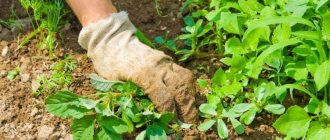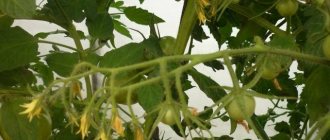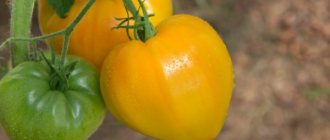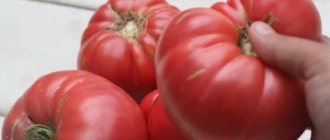Description and characteristics of the variety
The hybrid belongs to determinant, weakly branching tomatoes of early ripening.
Externally, the variety is a well-formed plant: a powerful stem 60-70 cm high, a large amount of dark green foliage, and practically does not produce stepsons. Ripening occurs 90-98 days after germination. Unlike many hybrids, the Baron f1 tomato is famous for its juicy pulp and excellent sweetish taste.
https://www.youtube.com/watch?v=zNzTMARaGnQ
Inflorescences of a simple type. The first appears after the 6th or 7th sheet. The clusters are strong, each developing 4-5 round tomatoes. The fruits are flat-rounded with a small spout at the apex, bright red, without a greenish spot at the stalk. They have a dense, fleshy structure, the number of chambers is 4-6.
The hybrid was created in Russia by NPF Agrosemtoms in 2000. State registration took place a year later, in 2001. The hybrid is recommended for growing in winter-spring rotation. For its cultivation, you can use film shelters, greenhouses and open ground.
The early ripening variety is quite popular and is often used as the main crop in private and small farms. The highest productivity indicators of the hybrid in open ground were registered in the southern regions of Russia.
To obtain a larger yield in the middle zone, it is necessary to use film greenhouses or shelters made of non-woven material. In the Trans-Urals and to the north, the hybrid is grown in greenhouses.
Description of the hybrid tomato Barin F1 and reviews from gardeners
Gardeners are interested in what the Barin F1 tomato is, reviews of which they saw on forums on the Internet. Hybrid tomato varieties are popular among experienced farmers and amateur gardeners. This popularity is mainly due to the fact that hybrid tomatoes have improved characteristics, higher yields and resistance to disease, unlike conventional varieties.
The Barin variety is a mid-season variety, distinguished by large fruits and can be grown in different regions of Russia. Note that this variety was recorded in the state register of the Russian Federation as a tomato suitable for cultivation both in private gardens and on an industrial scale.
Characteristics of the variety
Brief characteristics and description of the variety:
- mid-season;
- bushes are planted quite densely;
- suitable for growing in any conditions;
- characterized by tasty and dense fruits.
The tomato harvests 4 months after the first shoots appear. Planting in the greenhouse should be done after the sprouts, located in separate containers, are 55 days old. This variety can be grown both in greenhouse conditions (the main thing is that the greenhouse is not heated additionally) and in open ground.
Tomatoes must be planted tightly in the ground. You can plant 6-7 bushes per 1 m². Plants are of a determinate type, that is, they grow only to a certain height. Usually the height of a tomato bush reaches 1 m, sometimes lower. This allows you not to spend a lot of time caring for the plant, since it does not need staking, forming a bush into several stems - you only need a slight pinching at the very beginning of cultivation.
The bush itself is covered with dark green leaves, and its stem is quite strong and has short internodes.
Each inflorescence can bear 5-7 fruits. The tomatoes align themselves on the first bunch where they grow and form a single bunch. From 1 bush of the plant you can harvest about 11 kg of harvest with proper care and climatic conditions. Tomatoes are harvested at regular intervals.
Ripe tomatoes are characterized by excellent taste. They are quite large in shape: 1 fruit can reach a weight of 300 g, provided that the plant is regularly cared for.
The color of the fruit is rich red, the shape is round, slightly flattened at the poles. The tomato skin is glossy and smooth, well protecting the vegetable from cracking. Inside the tomato there is fleshy, dense and sweet pulp, divided into several seed chambers: there are at least 6 of them in a tomato. The sweet taste of the tomato is interspersed with a slight sourness.
Among the characteristics that distinguish this variety from others are the following:
- Good immunity. High resistance to common diseases, including tobacco mosaic virus and verticillium wilt, to which common tomato varieties are susceptible.
- Excellent yield and quality of fruits collected from the bushes. Even under unfavorable climatic conditions, including dry periods, the farmer can harvest a sufficient amount of fruit.
- Ripe fruits are well stored. They can stay in one place under natural conditions for about 1.5 months. The dense and smooth skin allows the harvest to be transported from one place to another without loss of presentation and taste.
Reviews from gardeners
“The average ripening period of the Barin tomato is good for our region. It stores well, so you can enjoy tomatoes for several months after the first harvest. The taste is sweet and sour, the balance is normal. Last year the harvest was good, but we were lucky with the weather, we’ll see what happens next.”
“I’ve been planting the Barin variety in the greenhouse for several years now. Everything ripens together and the tomatoes are the same size. In the open ground, the experiment did not work out so well, but there was a harvest, just smaller tomatoes. And so - everyone likes it, we eat, we don’t complain.”
“Growing Barin tomatoes in a greenhouse is just the thing. I didn’t reach the maximum yield, but I managed to collect 5 tomatoes per inflorescence. I’ll try to plant something else this year, if it doesn’t work, I’ll go back to Barin.”
Differences between tomato varieties
Each tomato variety has its own personality. Behind each are years of work by breeders and decades of popular selection. The beauty of the best modern tomato varieties is their diversity. So we “exploit” tomato hybrids and varieties with unlimited growth - indeterminate, semi-determinate, and determinate, the average height of which for the most part ranges from 70-80 cm, and low-growing vegetables, whose height does not exceed half a meter (all of them We will discuss the differences and features in the article below).
You cannot give advice based on outside experience, as some do, deliberately introducing not entirely truthful information about the yield (quantity and quality) of grown tomatoes. They say here they are - the best varieties of tomatoes of the past (and, further, in descending numbers) for tomatoes of the year. With everything, however, it should be noted that they often focus on plant varieties proposed for planting for open and closed ground, without understanding that the advice will be good only after personal experience - better after at least 3-4 years (honestly, but extremely rarely , and 2 are sometimes enough) and with meticulous experiments (starting with growing seedlings using the soil additive Vermiculite, the growth stimulator Gumi and, ending with fertilizing: magnesium sulfate, mineral fertilizer Fertika-Kemira and so on - already in the garden) for each variety.
Why am I giving such a deadline? Yes, because you definitely need to take into account the weather, which differs from year to year, and this is the minimum, in my opinion, period to have more or less an idea about each variety of tomatoes.
Immunity
Barin is very resistant to many tomato diseases: verticillium wilt and tobacco mosaic virus. Compared to other diseases, timely treatment is used, as with other varieties. Add ash to the soil. After all watering, sprinkle wet areas with dry soil. Periodically ventilate the storage area. Sometimes treatment is carried out by spraying a soap solution.
Advantages and disadvantages
Pros:
- The fruits on the cluster are approximately the same size, quite large.
- Can be used to produce early tomatoes for commercial use.
- Quite a productive tomato.
- Resistant to fluctuating weather conditions.
- Excellent immunity to a number of major diseases.
- Possibility of transportation over long distances.
- Perfectly stored.
- High commercial varietal qualities.
Minuses:
- During the growth stage, the watering regime must be strictly observed.
- If you do not purposefully engage in the formation of a bush, it will quickly end, give up the harvest and stop the growing season.
- Seeds must be purchased from the manufacturer every year.
Tomato growing technology
Our technology for growing tomatoes of different varieties is as follows. On our plot we allocate 6 long rows for tomatoes (including closed soil). On three of them, representatives of the best varieties of tomatoes, proven over the years, are grown (there are also tomatoes to choose from), guaranteeing a harvest according to the declared characteristics (regardless of the “delights” of the weather), and the other three are planted with new varieties, which are “considered” this way and that in during the above time. That seems to be it.
PS To make life easier for readers and reduce the time it takes to absorb the article, instead of determining the yield of vegetables in kg per 1 square meter, it will be written below - kg “per square”.
And now I am announcing the number of tomatoes tested in growing, presented below for your viewing, which can still be called the best - 60 varieties.
PS The results were recorded in an area that: with a good warm season, corresponds to the Central Black Earth region (region), and with a bad warm season, corresponds to the North-Western region. Naturally, this range of latitudes in which the above regions are located definitely includes Siberia, the Moscow region, the Middle Zone, the Urals, the Far East, and then figure out for yourself where exactly the paths lead to your site.
The best varieties of tomatoes
There are must-have varieties that I always plant every year. I like them not only for their taste and unpretentiousness, but also for the way they look on the bush. I’ll paraphrase one bearded joke: “I don’t really like tomatoes... But the process itself...”. I love going into the greenhouse and admiring the tomato plantations. And I don’t hesitate to show off my particularly spectacular huge tomatoes to my neighbors, and then post photos on the forum. It’s a shame to hide it – we all love it!
The following varieties are among the favorites also because they do not need to be fanatically cultivated and shaped. And they will always give a harvest: small, large, and a lot, depending on the variety and what I grow them for - for salads, for preparations, or, the smallest and sweetest ones, so that “like seeds, they click.” .
The “Rocket” variety is suitable for both greenhouses and open ground. The fruits are identical in shape and sweet. We love to eat them by the handful. Look good in blanks. The bush requires garter, despite the fact that the package says the opposite. This is because a lot of fruits grow, and the bush bends from the weight. Its height in open ground is about 40 cm, and in a greenhouse it can reach up to 60 cm. This is a mid-season variety; it does not need to be pinched.
Rice. 1. “Rocket” matures smoothly and is well stored in both technical and biological maturity.
I got the “Big Man” variety from a neighbor. During a tour of her greenhouse, I really liked the way it looked on the bush. The neighbor said that she has been planting it for a long time, that it is unpretentious and always sets fruit, even if the ventilation regime in the greenhouse is not followed. Of course, I took one fruit for seeding. “Zdorovyak” can grow up to 100 cm in height, so it is better to grow it in a greenhouse, although it produces large tomatoes in open ground.
Rice. 2. There is almost no need to pin the “Big Man” wrist.
Rice. 3. It ripens in batches, gradually, which is very convenient.
Among the vigorous-growing tomatoes with large fruits, I singled out the “Red Giant” variety. This amateur variety was bred by simple gardeners. Despite the fact that it grows a lot of leaves, it does not have to be pruned too often. The fruits on the lower tiers are the largest. If I had not been lazy and plucked out the inflorescences, leaving no more than 3-4 in the brush, the fruits would have been even larger. It is fleshy inside and contains few seeds.
Rice. 4. “Red Giant” in mid-July.
Rice. 5. You can take your own seeds, but the fruit must ripen on the bush and come from the second cluster from the bottom.
Rice. 6. The fruits are slightly ribbed, quite transportable, there is never a yellow-pink top from unbalanced care, as in pink-fruited varieties.
Rice. 7. Both the side of the stalk and the reverse side always have a marketable appearance.
Rice. 8. The only drawback of the “Red Giant” is that the largest fruits require a garter.
However, almost all large-fruited tomatoes require additional tying of the brushes. Except for my next favorite, Bull's Heart. I also always grow it year after year, as my grandmother advised me. “He will never let you down!” - she said, and every year I am convinced of this. Even if I took my own seeds and not factory ones, “Bull’s Heart” invariably bears fruit and does not require pinching at all, although it is vigorous.
Rice. 9. The hands grow in such a way that they do not need to be additionally secured with a garter to prevent them from falling.
Rice. 10. There is one feature of the “Bull’s Heart” - a predisposition to the formation of such gnarled fruits.
Therefore, if you see a bud or flower that is too large, feel free to cut it with scissors, it will still take a long time to ripen, even though it will be large, the skin will be hard and gray, you cannot take seeds from it.
Rice. 11. But the bulk of the “Bull’s Heart” fruits are very beautiful, tasty and fleshy. By the way, this variety comes in both orange and red.
Before you accurately choose a variety or hybrid of tomatoes, you need to decide where exactly they will grow.
For open ground, low-growing varieties that will ripen early are more suitable. Mid-ripening species in good summer weather can produce a fairly good harvest, but they are susceptible to microflora, which can destroy most fruits.
It is customary to grow tall varieties and various hybrids in greenhouses. Here you can plant absolutely any tomatoes, even late-ripening ones.
Features of cultivation and care
A distinctive feature of the hybrid is its high resistance to cold weather and general unpretentiousness. The tomato rarely gets sick, and is genetically protected from tobacco mosaic virus, cladosporiosis, and fusarium wilt. Most often, the plant is formed into one stem. During the fruiting period, it must be tied up, since the stem may not withstand the weight of the filling fruits.
To prolong the fruiting of determinate tomatoes, it is necessary to leave 1-2 stepsons for the horizontal development of the bush, when the top has already stopped growing.
Tomatoes store well. Thanks to the dense pulp with a high dry matter content of about 6%, tomatoes can last up to 1.5 months if storage conditions are met. The harvest of this tomato is stale and tolerates transportation well, which makes it possible to sell it outside the growing region.
Like other varieties of vegetable crops, Boyarynya F1 tomatoes are demanding of heat and nutrition. Caring for tomatoes includes common garden manipulations, which include:
- Watering. Since the hybrid is hypersensitive to high humidity, the bushes are rarely watered. For normal development in dry weather, the bushes only need one abundant watering per week. Provided that there is regular precipitation, the frequency of watering is adjusted based on the condition of the soil. To ensure good air flow to the roots, after watering the soil between the rows is loosened.
- Transfer. Tomato seedlings are picked twice: the first time when thickened crops are planted, and the second time when planting plants that have reached 55–60 days of age in a garden bed or greenhouse.
- Garter. Tall, and especially large-fruited varieties, to which the hybrid belongs, simply need support. Install pegs or trellises after the plants take root after transplanting to a permanent place. For maximum yield, bushes are formed into 2–3 stems.
- Feeding. Fertilize tomatoes with organic or mineral fertilizers. In the first stages of growth, the crop is pampered with mixtures with large amounts of nitrogen, and during fruit set - with potassium and phosphorus. It is impossible to overfeed tomatoes of any age with nitrogen, since under the influence of the substance green mass actively grows instead of tasty fruits. During the growing season, fertilizing is applied 2-3 times.
Description of the Barin tomato variety, growing characteristics and yield
It is not difficult to grow a crop on your plot; all you need to do is show a little hard work and patience. Tomato Barin is a variety with large fruits. Disease resistance and high yield are important criteria for selecting species for cultivation.
Indicators and characteristics of the variety
Choosing a new variety to plant is an important matter. The criteria of each summer resident differ from each other. The description will help you choose the types that suit your family’s needs.
- Height 80 cm.
- Ripens within 110–115 days.
- There are 5–7 tomatoes in one bunch.
- Flat-round shape.
- Weighing 250–300 g.
- Of red color.
- Has 6–8 nests.
- It is stored for 45 days.
- Carries transportation.
Planting and care
The tomato is suitable for growing in open ground and greenhouses. Summer residents use the seedling planting method. Only everyone determines the sowing time independently. Depending on the climatic characteristics of the region.
From the very beginning, small plants require attention and proper care. It is at this time that the foundation of the future harvest is laid. Deserves special attention:
- Lighting. 14 hours a day, if there is a lack of sunlight, specially installed lighting devices are used.
- Humidity and temperature.
- Feeding tomatoes. Complex preparations and growth-stimulating substances are used.
- Dive. This is done to make the plant more powerful. In a separate container, the root system forms faster, the stem becomes thicker and straighter.
- Hardening. Helps seedlings to more easily withstand the stress they experience when planted in the ground.
per 1 m2. It is necessary to pluck and tie up the bushes. Form into 2-3 stems. Feed at least 3 times: after transplantation, during budding and fruiting.
Water the tomatoes with warm water, preferably in the evening.
Hilling and loosening will provide oxygen access to the roots and help retain moisture in the soil. Mulching will serve the same purpose.
Plant immunity
Barin tomatoes are resistant to Verticillium wilt and tobacco mosaic virus. Preventive treatment is used to prevent the spread of other diseases.
Use of vegetables in everyday life, harvest volume
Ripe fruits are used for any purpose. Fresh salads and various types of winter preparations are prepared from them. Processed into juices, pastes, sauces. The only disadvantage of this variety is that large fruits are not suitable for whole canning.
The yield of the variety is 9–12 kg per 1 m2.
Positive and negative about the properties of tomato
As the characteristics of the species show, the presence of positive qualities predominates. This is a significant advantage when a summer resident chooses a variety to plant.
- Tomatoes do not crack.
- Productivity.
- Shelf life 1.5 months.
- Does not depend on adverse conditions.
- Resistant to elevated temperatures.
- Immunity to diseases.
What do summer residents say about the Barin variety?
Vegetable growers find recommendations and useful tips by reading reviews on cultural websites. Gardeners express their opinions and evaluate tomatoes.
- Alla: “We planted several bushes. It turned out pretty good for a first try. I was pleased with the harvest and the taste is excellent.”
- User: “I’m planting tomatoes in a greenhouse. There was an attempt to grow it in open ground, but the yield decreased. I recommend it for planting in protected ground."
- User: “The bushes are low, there are 5 fruits each. in the brush. I really like the variety."
The Barin tomato variety is unpretentious and undemanding to care.
I. Hybrids
Hybrid tomatoes are virtually guaranteed to be resistant to diseases and bad weather conditions, which is something that non-hybrid varieties suffer from. Greenhouses and greenhouses are valued for storing heat, but in them tomatoes can suffer from too high temperatures and sudden temperature changes. In recent years, world selection has been aimed at producing “heat-resistant” hybrids with a reliable guarantee of ovary production.
Hybrids are especially helpful in a greenhouse or a small garden plot where there are no real opportunities for crop rotation and diseases are prevalent. Selection successes demonstrate confident resistance to various types of infections - viral (especially the most dangerous tobacco mosaic virus), fungal, bacterial. In addition, the hybrids have uniform fruits and consistently high yields.
Tomato Incas F1
One of the best hybrids for canning whole fruits without skin. Popular early high-yielding bush hybrid. The plant is medium-sized, compact.
Tomato from the Dutch company Numens, zoned in Russia; entered into the state register in 2000. Mid-early hybrid (105 days) of meter-high vegetables, determinate. Very high resistance to fungal diseases has been recorded. The fruits are 80-100 g, dense, bright red, pepper-shaped, fleshy, uniform, tolerate sunburn well, are very easy to ripen, transported over long distances without loss of quality.
Tomato Torquay F1
Dutch hybrid from Bejo Zaden; in the Russian register since 2007. Mid-season tomato (119-123 days from germination to ripening), bush type - determinate, maximum height 100 cm. Forms abundant multiple clusters with fruits weighing 60-140 g. Dense tomatoes withstand long-term transportation, excellent in pickling and pickling matters.
Tomato Mariana F1
The tomato was created in the French branch of the Japanese company Sakata (the image of the woman Mariana is a symbol of the French Republic). The breeders of this agricultural company are often suspected of producing GMOs, but so far without real evidence. Mariana is a mid-early determinate hybrid. The fruits are similar in shape to Incas - also elongated-oval, perfectly smooth, super dense.
Tomato Bagheera F1
Hybrid from the leading French seed company Cloz. Included in the Russian seed register in 2007.
Early high-yielding hybrids are a real boon for the garden. They are cold-resistant, do not need pinching or tying up, and practically do not get sick. The ripening period is marked as medium-early; determinate bush. The fruit is round, flattened on top, ribbed, weight ranges from 80-220 g. The hybrid is resistant to soil drought and nematode, more suitable for regions located in the south. Does not suffer from fusarium and verticillium wilt.
Tomato F1 Semko 2005
The tomato is suitable for open ground and under film shelters (greenhouses). Determinate, medium-sized, compact. Resistant to soil salinity, drought, high temperatures, grows well in open ground in both southern and northern regions. Vegetables practically do not suffer from viral and fungal diseases, even late blight.
Tomato F1 Semko 2010
Included in the state register in 2010. Ultra-early ripening determinate hybrid - 85-88 days pass from the sprouting of green vegetables to the coloring of fruits. The first brush is formed immediately after the sixth leaf grows. The fruits are incredibly dense for such an early tomato, and are by no means small - 130 g. The shape is round hearts with a beautiful pointed tip.
The newest indeterminate hybrid (on the register since 2015) - tested by us, everything is fine - created taking into account all possible greenhouse disasters. Firstly, it sets well even in the heat, as well as during temperature changes. Secondly, it is tolerant of problematic soil substrates. Thirdly, it shows high resistance to viral, fungal and bacterial infections.
The yield of vegetables varies between 20-30 kg/1 square meter. Mid-early hybrid (100 days from green shoots). The clusters begin to form after 7-9 leaves, each bears 5-6 tomatoes in the shape of rounded hearts, smooth, beautiful, attractive orange color. The weight of the “heart” is 160-190 g. The pulp contains a high percentage of dry matter, sugars, and carotenoids. The fruits are quite dense and do not wrinkle during transportation. Purpose: salad. Created as an orange variant of another hybrid - Tomato Pink Spama.
Bushes of unlimited growth, with dense foliage. Mandatory shaping is required, including a garter. Hybrid of medium early or medium ripening period (112-118 days). Clusters of 6-8 tomatoes weighing 130-150 g. The fruits are plum-shaped, slightly tapering downwards. They are deep red in color, thick-skinned, with a high percentage of dry matter.
Tomato Empire F1
Indeterminate hybrid of a new generation, in the state register since 2011. Medium-early (100 days - 2 days - from germination). The plant is tall, much taller than other types of tomatoes. Therefore, the tomato requires gartering and pinching. Tomatoes are oval-shaped with a spout, weight ranges from 80 to 140 g. On average, 9 kg are obtained per bush. The color of the fruit is red-orange. The skin and pulp are dense. Can be stored for 6-7 weeks. In greenhouses people do not suffer from viral and fungal infections.
On the register since 2015. The bushes are semi-determinate, beautiful, a meter and a half high. Suitable for any soil - open or closed. Plants require pinching. Multiple clusters bear up to 30 fruits with a sweet taste and a perfect “strawberry” shape. The weight is typical for classic cherry tomatoes - 25 g. Thanks to the strong skin, the fruits can be stored for a long time. Early hybrid: ripe fruits appear 91-93 days after the sprouts emerge. The plant is resistant to Fusarium wilt.
Tomato F1 Kaspar
The bush is short, usually up to the first cluster, 60 cm. The fruits of the plants are cylindrical with a spout, the length varies around 11 cm, and the weight is 95-115 g. They are very dense, without juice. It is convenient to pickle them assorted with cucumbers of a similar size.
The average ripening period is 115 days. The hybrid is intended for open ground, or is planted under low shelters; We plant three to four vegetable bushes per square.
Tomato Aunt Valya F1
Valya f1 tomatoes are early-ripening, tall hybrids with average yield. The bushes easily and quickly reach a height of 200 cm. In the register since 2015. Productivity is within 20 kg per square meter. On average, one bush produces 7 kg of tasty and beautiful tomatoes. Tomatoes ripen simultaneously, reaching 200-250 g in weight.
The fruits have a regular round, slightly oblong shape. The scope of use of tomatoes is very wide. Salads are prepared from the first fruits. As the volume of the harvest increases, the fruits are used for winter harvesting, as well as juices, ketchups, pastes, sauces and lecho. Tomatoes retain commercial quality for a long time and tolerate transportation and long-term storage well.
Description and characteristics of the hybrid tomato variety Yaki F1
The Yaki F1 tomato, an early, high-yielding hybrid of Dutch selection, has become widely used by domestic farmers and has earned excellent reviews. A hybrid of determinant type, recommended for growing in open ground.
The period from sowing the seeds into the soil until the ripening of the first fruits is 100-105 days. The stem of the Yaki F1 bush is powerful, stable, the leaves are dark green and wide. This hybrid does not require mandatory tying to a support or pinching. The first ovary appears after 4-5 leaves. During the season it can produce 10-12 bunches of tomatoes.
Fruit characteristics
The fruits of the hybrid tomato Yaki F1 are plum-shaped, round, bright red, without greenery at the stalk, dense, sugary. They are easily torn from a bush without a stalk. Fruit ripening occurs 65-70 days after seedlings are planted on the soil. The weight of one fruit of these tomatoes, depending on growing and care conditions, ranges from 85 to 140 grams.
Taste and technical characteristics
The Yaki F1 tomato variety has good taste and aroma. The dense, fleshy consistency allows you to obtain high-quality tomato paste during factory processing. The thick skin retains a pleasant taste and firmly holds the shape of the tomato in brine and marinades, in slices and homemade salads.
The Yaki F1 tomato also earned rave reviews from housewives for its sugary pulp. Sauces, purees and ketchups made from these tomatoes are tasty and beautiful. Yaki F1 is easily transported and stored. After being removed from the root, unripe tomatoes can be stored for 1.5-2 months in a cool place or in the refrigerator.
Features of cultivation
The hybrid tomato Yaki F1 was specially adapted by the developers of this variety for growing in open ground. An unpretentious, cold-resistant tomato, suitable for industrial cultivation in vegetable farms. Gives friendly crop shoots, i.e. Most of the fruits ripen almost simultaneously.
The yield of this hybrid is 7-8 kg per 1m2, which exceeds the yield of its closest competitors.
Direct sowing of tomatoes of this variety in the ground is not recommended, since the growing season of the plant is lengthened and the yield is reduced. In addition, under such conditions it is impossible to obtain an early harvest. Yaki F1 tomato seeds are sown 6-8 weeks from the last expected frost date in the region. Sowing is carried out in illuminated warm rooms, heated greenhouses or greenhouses.
Optimal germination of sprouts occurs after 7-14 days at constant soil moisture and temperature. An important point for obtaining healthy and fertile tomato seedlings is the optimal combination of humidity and temperature. A description of the requirements for water quality for irrigation and soil moisture is given in the table.
| Soil moisture | Water quality requirements for irrigation | ||
| transplanting | 65-75% NV | acids | absence |
| beginning of fruit formation | 76-82% NV | impurities | absence |
| first fees | 70-80% NV | total salt content | 1100-1300 mg/l |
| end of growing season | 85% NV | pH environment | close to neutral |
| oxygen saturation | maximum |
Planting of ready-made tomato seedlings is carried out according to the 50 x 40 cm scheme, 3-4 plant bushes per 1m2. It is possible to plant up to 6 bushes per 1m2.
To obtain abundant harvests, the correct selection of a site for planting is also necessary. It must be remembered that it is ineffective to plant the Yaki F1 hybrid on the ground after vegetable crops such as onions, potatoes, cabbage, and eggplants.
Disease resistance
| № | Type of disease | Degree of stability |
| 1 | verticillium wilt (V-1) | high |
| 2 | fusarium wilt (races 1,2) | high |
| 3 | Alternaria stem cancer | high |
| 4 | Bacterial fruit spot |
(BSK-0 (IR)
medium 5 tomato nematode high
Advantages and disadvantages
Characteristics of the advantages of the Yaki F1 tomato:
https://youtube.com/watch?v=F6WY3qaH7KY
- does not require obligatory garter to the support;
- does not require removal of stepsons;
- resistant to low air temperatures;
- does not require closed cultivation in greenhouse conditions;
- the fruits ripen almost simultaneously;
- suitable for industrial cultivation;
- suitable for machine harvesting;
- high productivity;
- used for factory preparation of tomato paste, sauce, puree;
Tomato is resistant to major diseases.
Characteristics of the disadvantages of the Yaki F1 tomato:
simultaneously yields almost the entire harvest.
Planting and care
Sowing is carried out in the second half of March or early April. The seeds are placed in boxes with prepared soil and sprinkled with 1.5 - 2.5 cm of soil. The minimum germination temperature is 20 °C. Picking is carried out at the stage of two true leaves. A week before planting, tomatoes begin to harden.
Grown seedlings are transferred to open ground after the end of return frosts (June 5-10 for the non-chernozem zone), while they can be transplanted into greenhouses at the end of April.
Easy care:
- watering with warm water in the evening;
- ventilation allows you to maintain low air humidity and not overheat the tomatoes;
- when the fruits begin to form and ripen, the bushes are fed weekly with complex fertilizers;
- loosening or mulching of the soil is carried out throughout the growing season;
- Bushes that have gained fruit mass are promptly tied to the support.
Early maturing / Low growing
User rating: 3.3/5
Mid-season / Low-growing
User rating: 5/5
Early maturing / Low growing
What do summer residents say about the Barin variety?
Vegetable growers find recommendations and useful tips by reading reviews on cultural websites. Gardeners express their opinions and evaluate tomatoes.
- Alla: “We planted several bushes. It turned out pretty good for a first try. I was pleased with the harvest and the taste is excellent.”
- User: “I’m planting tomatoes in a greenhouse. There was an attempt to grow it in open ground, but the yield decreased. I recommend it for planting in protected ground."
- User: “The bushes are low, there are 5 fruits each. in the brush. I really like the variety."
The Barin tomato variety is unpretentious and undemanding to care.
II. Indeterminate varieties (unlimited growth)
These are tomatoes that will grow until they turn blue until the owner or the onset of the cold season stops them. They have great yield potential, which is more successfully realized in high greenhouses. We place approximately three bushes on 1 square. With supports such as strong trellises, open ground is not prohibited, which will be especially welcome in the southern regions.
Tomato Scarlet candles
Good for pickling, sweet. This is a patented mid-early variety (Siberian breeders distinguished themselves!). In the state register since 2007. They are characterized by a high ability to form ovaries in any conditions. From 1 sq.m you can actually get a bucket and a half. The clusters are arranged in tiers, the weight of the fruit on the lower branches reaches 120 g, on the top ones - half as much.
Very lightweight. A mid-early Siberian variety for canning whole vegetables. The fruits are elongated, reaching (maximum in our conditions) 13-14 cm in length, weighing about 120 g, and have a beautiful crimson hue. They have few seeds, are very fleshy, strong, and easy to keep. If they are picked green, they do not spoil and ripen perfectly.
The longest
A new product of Siberian selection. It begins to ripen already on the 110th (you can add a couple more) days from the sprouts appearing on the surface of the soil. Fruits have a unique length - 20 cm (specific size)! They are very elongated, with a small pear-shaped constriction in the upper part, uniformly slightly expanding downwards, with a spout. Vegetable clusters bear up to seven red fruits weighing up to 180-190 g. The product is successful in transportation, long-term storage, and pickling. Collection - at least a bucket from three plants.
High yield
The variety is productive and unpretentious. Tolerates slight shading. It ties well. Neither high nor low temperatures are scary. It succeeds in protected soil, but outdoor cultivation is not prohibited. Tomatoes begin to ripen in 106-113 days; at the same time, the plant successfully continues to grow and form clusters - up to 10 pieces per bush.
Each bears up to eight graceful fruits - cylindrical and pointed, in full ripeness - iridescent pink in color. The weight of each vegetable is 100-120 g. They contain a high percentage of sugars and dry matter. They do not burst when pickled, are good for drying, obtaining thick juice and, oddly enough in your opinion, for making tomato jam. With diligent care, the bush can bear up to a bucket of quality fruit.
Tomato Niagara
Weighty brushes
This mid-early vegetable variety has been on the state register since 2010. The bush is tall, but compact in width. It has a highly branched root system, responsive to increased nutrition and good water supply. A valuable feature of this Siberian variety is its multiple clusters, each of which bears up to 14 fruits weighing 85-115 g.
Meaty and sweet
This is one of the sweetest and meatiest products of Siberian breeders. It has been registered in the state register since 2007. The tomato is mid-season (116-118 days from the appearance of sprouts), with large foliage. The fruits resemble long, sharp peppers - they grow up to 15 cm. They are an elegant red color, the weight ranges from 120-185 g. The pulp of vegetables contains very little water and seeds. In the best case, there are up to a dozen fruits in one cluster. One bush gives 2-3 kg.
Tomato Koenigsberg
Excellent ovary
Included in the state register in 2005. The variety rightfully takes its place among the most productive Siberian varieties (up to 20 kg per square meter of land in a greenhouse). It sets perfectly even in the hot atmosphere of closed ground. Plants with a powerful bush with large leaves require increased nutrition and careful pinching.
The first ovary is formed after the growth of the 12th leaf, then inflorescences are formed every 3 leaves. Refers to varieties of medium ripening; in Siberian conditions, approximately half of the crop ripens; the rest of the fruits turn red quite well when ripened. Tomatoes in the lower clusters of vegetables weigh 300 g, and in those above - no less than 150 g. The shape is elongated, heart-shaped, smooth, and beautiful.
Vitamin and sweet
Ripe tomatoes have a golden-orange color and contain a record amount of carotene vitamins. The pulp is sweet and aromatic, like berries and fruits. The ripening period is average. The lower fruits are capable of filling up to a mass of 400-450 g, higher up the bush - 200-300 g. They are oval, often with a spout. The plants grow clusters through the leaves, each containing on average, as stated, up to 5 fruits. Productivity is high. The keeping quality is excellent. It is especially tasty when salted with gelatin.
Harvest hearts
Close internodes and a powerful trunk with dense foliage are like standard varieties, only the height is two meters. The Siberian breeding novelty produces half a bucket of fruit from one such “tree”. Ripening begins on the 115th day. Forms up to 6 beautiful clusters with 5-7 red tomatoes weighing 200-250 grams, shaped like strawberries.
Tomato Budenovka
Resistant to cracking
The variety is an improved version of Ox Heart, with a higher yield (about 9.4 kg per square), early ripening, good resistance to diseases (even to late blight) and cracking of the apical tissue of the fruit for a fleshy variety. Heart-shaped, ribbed tomatoes with excellent taste.
Record weight
The variety is a new product from a team of breeding scientists under the leadership of V.F. Gavrisha. Registered in the state register in 2015. Due to the unrealistically large fruits of vegetables, it is included in the “Russian Hero” series. The variety is not very fast in terms of ripening time (from 120 days), therefore it requires early planting of seedlings, especially careful pinching and decent feeding.
In Siberia and Central Russia it works well only in closed ground conditions, including a greenhouse. The average return from a bush is 3.6 (plus or minus) kg, the record is 7 kg. The tomatoes are flat-round, slightly ribbed, have an excellent smell and are very juicy, each weighing 400-600 g, not uncommon - 800 g. There are 2-3 tomatoes in one cluster of plants; if you leave only one tomato in it, it can pull more than 1 kg. Such “bogatyrs” are better suited for salads and distillation for juice.
Bowl of salad from one fruit
One of the best salad novelties, the yield is high. The plant bears 5-6 racemes. The fruits look very attractive due to their raspberry-pink color, large up to 500-800 g. The tomatoes are flat-round, ribbed, sweet. There is high resistance to cracking; The pulp density is average. A rare quality for large-fruited varieties: the fruits do not tend to quickly soften and spoil during storage.
According to the ripening period, the variety is classified as mid-early and mid-ripe. Perfect for preparing preparations: tomato paste, juice. This tomato variety is characterized by high yield. You can remove up to 5-6 kilograms of tomatoes from one bush.
Giant orange sweet
It has plasticity, rare for a large-fruited variety, and relative unpretentiousness. Delicate sweet pulp combines with excellent keeping quality. The tomatoes are round-flat (their “ribs” stand out a little), sunny orange in color. The average weight of a tomato is 0.5 kg, but in reality there are 1 kg of fruit on the bush.
